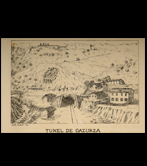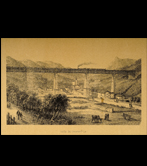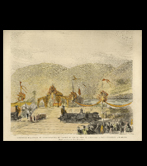Building the Northern Railway Line
Although there were precedents in the building of railways, the key to the development of the Spanish rail network was the Ley General de Ferrocarriles (Railway Law) of 1855, which regulated all aspects of this new form of transport. Among other things, this legislative framework encouraged the investment of foreign capital to finance railways, which was a decisive factor in the case of the Northern Railway.
With the aim of linking Madrid with the French frontier (the railway had already arrived Baiona in 1854) a credit society, the Sociedad para el Crédito Mobiliario Español, mainly made up of French capital, and linked to the Péreire family, was established. The route was laid out from Madrid as far as an as yet indeterminate point on the Ebro, without it being clear what route it would take to the frontier. There was a dispute between those who wanted the line to pass through Álava and Gipuzkoa towards Irun, and those advocates of what was known as the “Alduides line”, who wanted it to go through Navarra and to connect Baiona via Pamplona.
The authorities in Gipuzkoa were well aware of the importance of the railway and commissioned Fermín Lasala, the future Duke of Mandas, to push for the Gipuzkoa route. He was confronted by the people from Navarra and the Rothschild family, in turn in a standoff with the Péreire family and their railway investments. In the end, the Gipuzkoa proposal won, thanks to a large subsidy received by the Sociedad para el Crédito Mobiliario Español. The Diputación then opened it to popular subscription and it was a great success.
Work began in 1858. It crossed Alavá without problems, but the need for numerous tunnels and bridges in order to cross the mountainous terrain of Gipuzkoa - work that was contracted out to small local businesses – slowed construction. The Compañia del Norte commissioned a French company with experience of building the trans-Alpine railway to carry out the work on the most difficult stretches. From 1862, numerous Piedmontese, skilled in tunnel construction, began to arrive in the Goierri area, and it appears that they brought with them the diatonic accordion from the north of Italy, which is the origin of the popular trikitixa. Finally, after constructing more than 14 km of tunnels and viaducts (the most important of which, at Ormaiztegi, was also the last stretch to open), the construction of the Northern Railway was completed in the summer of 1864. Irun was connected to Hendaia and by this means it was now possible to travel from Madrid to Paris by train.
During the first 10 years that it was in operation, the Company did not receive the expected profits, as much because of financial difficulties (the work cost double the budgeted amount) as because of the scarce traffic on the Castilian stretch, as well as problems arising out of the Second Carlist War. However, it played a key role in the province’s economic development because it linked areas that were in the forefront of industrialization such as Tolosa, San Sebastián and Rentería, with Irun, Hernani, Ordizia and Urretxu as well as some smaller areas such as Beasain and Zumarraga, thus boosting their industry.




